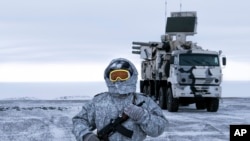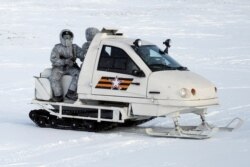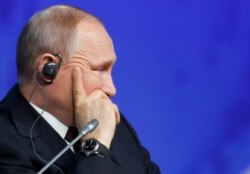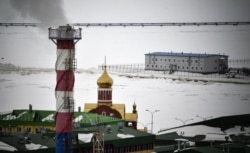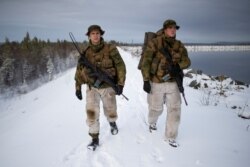From launching the world’s first “combat icebreaker” to training soldiers on how to handle sleds pulled by reindeer, from rebuilding Soviet-era airbases and radar stations to adapting weapon systems and armored vehicles for cold-weather warfare, Russia is bolstering its military presence in the Arctic - and is keen to advertise the fact with war games and test firings of new missiles.
The Kremlin’s growing assertiveness is aimed to position Russia as the dominant power in the Arctic with an eye on untapped offshore oil and gas reserves, which are becoming more accessible because of warming temperatures, retreating polar ice and rising sea-levels, say Western analysts.
After conducting a major military exercise in the region involving 12,000 soldiers, five nuclear submarines, 15 warships, including the nuclear-powered battle cruiser “Pyotr Velikiy,” and 100 aircraft, Russia launched Friday what it dubbed a combat icebreaker from the Admiralty Shipyard in St. Petersburg. The heavily armed icebreaker, the Ivan Papanin, is likely to be equipped with Kalibr cruise missiles as well as a 76.2mm gun and Ka-27 anti-submarine helicopter when it enters service by 2023. A second combat icebreaker will be plying the region the following year.
Admiral Viktor Cherkov told Russia’s Tass news agency: “We wanted to create a ship that would ensure the safety of our fleet in the Arctic. At the same time, we wanted the ship to carry out scientific research in the Arctic ice and, of course, for it to reliably ensure the safety of our national interests there.”
One of Putin's key goals
President Vladimir Putin has made Russian development of the Arctic one of his key long-range goals, and has talked ambitiously this year of enticing shippers away from the Suez to plying the Northern Sea Route instead. Some international investors are already buying into projects to export liquefied natural gas along the route.
Russian officials say their assertive military posture is in response to NATO maneuvering in the region and to ensure the Arctic remains a peaceful space. But Russia’s highly marketed activity with a series of missile test firings is clearly meant to send a message and to buttress Russia’s claim to around half a million square miles of the Arctic.
Last month, Russian officials claimed they had obtained new data that supports their territorial claim which Moscow filed in 2015 with the United Nations. Under the 1982 U.N. Convention on the Law of the Sea countries can claim an area of the world’s oceans as part of an extended continental shelf.
The U.S. Geological Survey estimates that the Arctic holds 90 billion barrels of the world’s undiscovered oil - about 13% - and 30% of its undiscovered natural gas. Russia, the U.S., Canada, Denmark and Norway have all made a variety of jurisdictional claims over parts of the Arctic.
The military exercises Russia just concluded in the Arctic and Far East were, in fact, an annual event, but this time round the Kremlin appeared determined to highlight the event with major announcements and declaring that Putin was personally supervising the war-gaming. The exercise also involved “a fantastic number of missile launchers of Strategic Missile Forces,” according to Dmitry Stefanovich, an analyst with the Kremlin-funded Russian International Affairs Council think tank. He told CBS News that more than 200 launchers were involved. “It's the majority of what they have,” he said.
Tensions in Arctic
At the request of Norway and other Scandinavian countries as well as Baltic states, NATO has stepped up its activity in the Arctic, especially around the Kola Peninsula, home to Russia’s Northern Fleet. Since the 2014 annexation of Crimea by Moscow, Russia’s near neighbors have become increasingly alarmed at Moscow’s assertiveness, prompting Norway and adjacent countries to urge NATO to rethink military strategy in the region and become more forward-leaning.
But writing last week in a Norwegian newspaper foreign minister Sergey Lavrov blamed NATO for heightened tensions in Arctic. “Norway is deviating from its ‘basic policy’ by deploying in its territory training bases for U.S. and UK military personnel in peacetime, which are allegedly based on the ‘rotation' principle but are in fact permanent facilities.” He complained about NATO war-gaming describing, pointing to the recent Trident Juncture NATO exercises as being “highly aggressive” and “near the Russian borders.”
In April at an international Arctic forum Putin said Russia plans to have by 2035 a fleet of 13 heavy icebreakers, including nine nuclear-powered ones. Russia has five nuclear-powered icebreakers currently, the only country to have any. Putin said he wants to expand port facilities at both ends of the Arctic shipping route — Murmansk on the Kola Peninsula and Petropavlovsk-Kamchatsky on the Kamchatka Peninsula.




